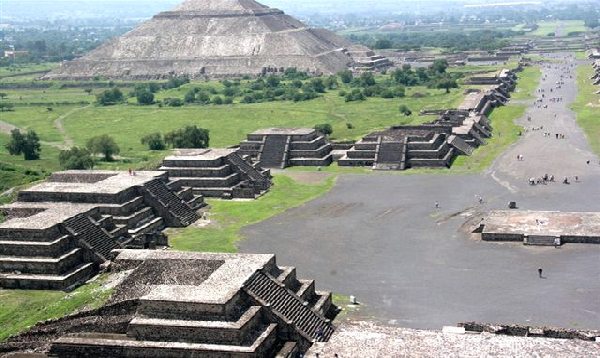Mexico City — Archaeologists say they have turned up about 150 skulls of human sacrifice victims in a field in central Mexico, one of the first times that such a large accumulation of severed heads has been found outside of a major pyramid or temple complex in Mexico.
Experts are puzzled by the unexpected find of such a large number of skulls at what appears to have been a small, unremarkable shrine. The heads were carefully deposited in rows or in small mounds, mostly facing east toward the rising sun, sometime between 660 and 860 A.D., a period when the nearby city-state of Teotihuacan had already declined but the Aztec empire, founded in 1325, was still centuries in the future.
Georgia State University archaeologist Christopher Morehart, who found the skulls last year in Xaltocan, a farming village just north of Mexico City, said that between 150 and 200 adult skulls or their equivalent in bone parts have been excavated so far from fields that stand on a former lake bed.
Experts weren't expecting to find anything of this kind in the flat, undistinguished pasture land and corn fields. The site is near, but not immediately adjacent to, Teotihuacan, one of the biggest pre-Hispanic cities. It reached its height between 100 B.C. and A.D. 750 and was abandoned by the time the Aztecs arrived in the area in the 1300's.
Morehart was conducting a study of ancient agricultural patterns and human landscape uses in the northern part of the Mexico Valley in 2007, when during a walking survey of the site he started noticing looters' pits that had turned up human bones. A subsequent season of excavations in 2012 turned up dozens more skulls. The results of the 2007 dig were just published in the academic journal Latin American Antiquity.
While the Teotihuacan culture and the Aztecs were known to practice human sacrifice, and remains of hundreds of victims have been found in their pyramids or other large structures, the Xaltocan mound "is like a bump in the landscape that you could really easily walk over and not know you're standing on it," Morehart said.
 |
| Archaeologists work at the site where skulls were found in a field in Xaltocan, near the Teotihuacan pyramids in central Mexico |
"The interesting question is, why are we seeing this kind of sacrificial act that we often associate with something like Teotihuacan or a big center? Why do we see this ... in a place that's not associated with these cities?"
Physical anthropologist Abigail Meza Penaloza of the Institute of Anthropology at Mexico's National University said her team was still cleaning and assembling the skulls, but have a confirmed count of about 130 skulls so far, all of which appear to be of adult males.
Meza Penaloza said it was the first find of its kind, both because of the location — a small, artificial mound built in the middle of an agricultural field — and the kind of decapitations carried out there. She said mass sacrifices had been documented at temple inaugurations of temple closings, but not in the middle of fields.
She said it was also unusual in that the skulls appear to come from a varied population, including people who practiced cranial deformation and others who did not, as opposed to more homogenous groups of sacrifice victims found in the past.
The skulls were also found with a shorter length of vertebrae attached to the skulls than is the case of other such finds, suggesting the decapitation cut was made closer to the base of the skull.
Still other strange details emerged: Morehart said some of the skulls were found with finger bones inserted into the eye sockets. "It was common enough that it was intentionally placed there in the eye socket," Morehart said, though the ritual significance of that remains unclear.
Arizona State University Dr. Michael E. Smith, who was not involved in the project, said "this is certainly an impressive and very puzzling find," adding, "I am not aware of any other finds of mass burials or mass sacrifices outside of major settlements."
The key to the placement might be the natural springs that provided fresh, clean water in an area dominated by shallow, brackish lakes. The springs existed for centuries until they were covered and tapped by pipes around the 1950's. The ancient inhabitants of Xaltocan apparently used those springs to water lakebed farm plots. Carvings associated with the water-god Tlaloc and corn and chile plants were found at the excavation site, suggesting it may have been an agricultural shrine.
There were also indications that the site remained a ceremonial spot for centuries after the human sacrifices ended, and perhaps is still used for that purpose. Morehart said researchers found a plastic bag containing a black candle, an egg, and paper streamers wrapped around photographs of people at the site, what one local worker suggested was a form of witchcraft.
"They were attracted to this spot for some reason, and even in the colonial period people came back and did rituals there, even after the Spanish came," Morehart noted. "The spot has been integrated into something religiously significant across several centuries."
Smith said it is possible that, as archaeologists start excavating more ancient farm sites, they might discover more evidence of large-scale rural sacrifices. "Very few rural areas or rural shrines have ever been located, so it is hard to say that this site represents an unusual find. It certainly is unusual for being the first such feature excavated by archaeologists, but it is possible that such shrines were more common in ancient times; we simply have no idea."


